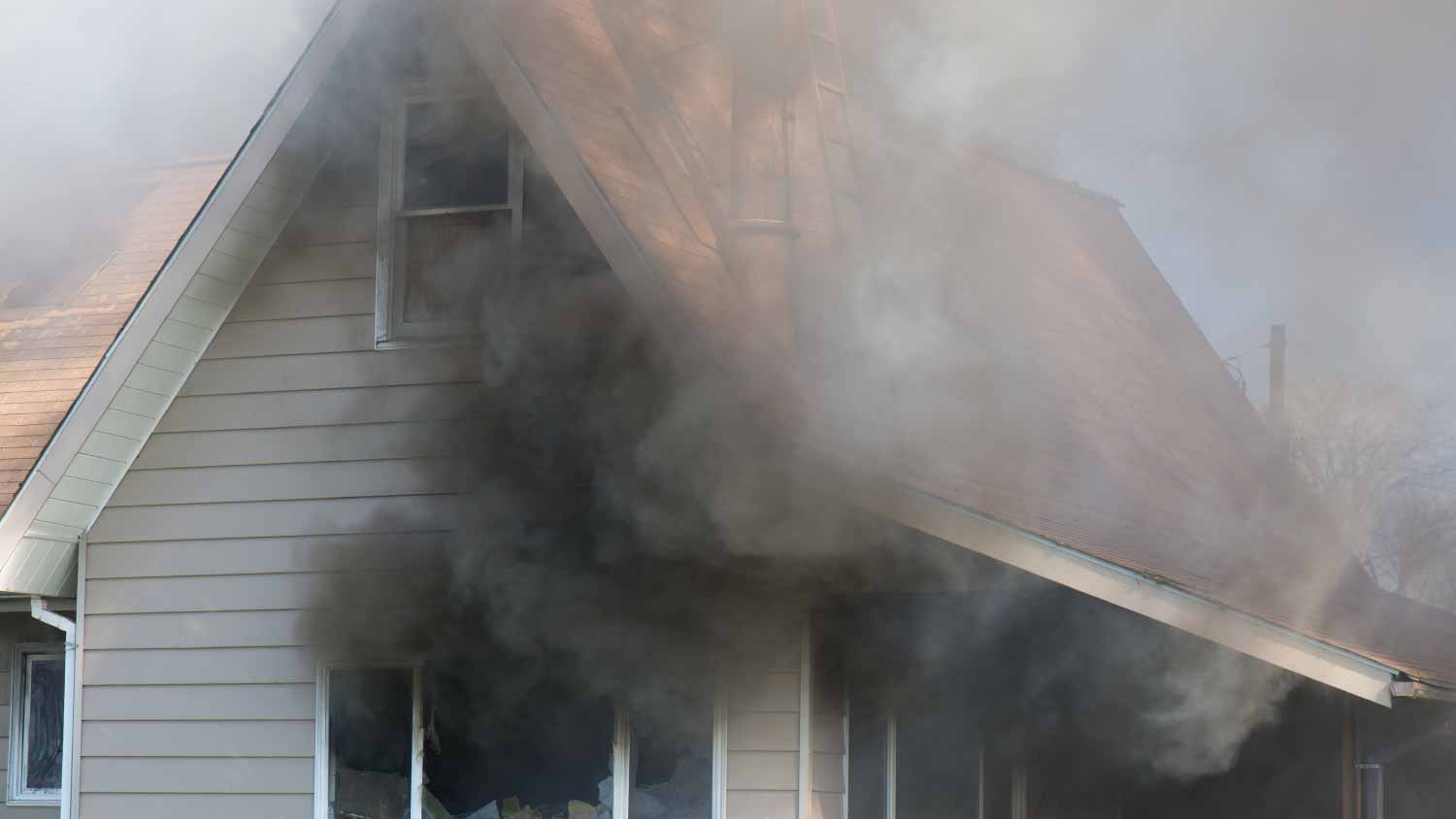
Your dry rot repair cost will depend on factors such as the extent and size of the damage and its location within your home. Here's what you need to know.
Smoke damage isn’t easily snuffed


Smoke damage is damage caused by the smoke from a fire.
Because smoke and soot can linger after a fire, it can corrode and damage items in your home.
Porous items are especially susceptible to smoke damage.
A smoke remediation professional can help you properly clean your home from smoke damage.
Fire can be devastating not just because of the flames but also due to smoke damage, which can permeate almost any object in your home. Smoke damage causes staining, corrosion, and other issues, and it works fast. Protect yourself, your home, and your belongings by understanding the different types of smoke damage and how to perform restoration work after the worst has occurred.
Smoke damage is damage caused by smoke from a fire. Smoke damage is different from fire damage—while smoke doesn’t immediately damage or destroy buildings and objects, it can cause long-term damage if untreated.
After you’ve put out the flames from a fire, smoke can linger and continue to corrode and discolor items in your home—as well as your home itself. Smoke can spread to places where fire wasn’t even present, penetrating cracks and crevices. In addition to smoke, fires can leave behind soot, which discolors items and prolongs the cleaning process—soot can make its way into fabric, upholstery, and appliances.
Signs of smoke damage can include:
Discolored walls, ceilings, floors, and more from soot residue and buildup
Corroded or damaged structural materials, pipes, and wiring
Lingering smoke odor
Damaged and discolored furniture and textiles
Poor air quality due to soot or smoke in HVAC system, ventilation, and filters
Sticky or filmy residue on surfaces
Malfunctioning or corroded electronics or appliances
Blistering or bubbling paint
Use a HEPA vacuum and dry chemical sponges to remove surface soot before applying specialized cleaning solutions. Avoid water, as it can spread the residue.
— Felicia Wilkes, Comfort Specialist at A-One Refrigeration & Heating Inc

There are different types of fires, and therefore, also different kinds of smoke and smoke damage. Knowing what kind of smoke damage you’re dealing with will help you with the smoke damage restoration process.
Caused by fast-burning, high-temperature fires fueled by paper or wood, dry smoke has a powdery texture and is, therefore, easier to clean than some other types of smoke and soot. Unfortunately, though, dry smoke can easily get into cracks and crevices, including porous material; it is known to damage HVAC systems, wiring, and foundations.
Protein smoke residue comes from organic matter that has evaporated during a low-heat fire. Most commonly, this kind of smoke comes from a cooking mishap and subsequent fire. Without a noticeable soot or streak, protein smoke is difficult to detect. It can permanently discolor painted, varnished, or other finished surfaces, though, and leaves a strong, unpleasant scent.
Wet smoke comes from burning plastic or rubber goods that have been smoldering at a low heat. Due to its source, this kind of smoke smells strongly of burnt plastic. It also leaves behind a thick, black smoke; its residue is sticky and dense. Wet smoke can easily cover your home’s surfaces and smears during the cleaning process, making it difficult to remove without special equipment managed by a local smoke restoration company.
Fuel, or petroleum, smoke is rare to find in a home unless petroleum is being stored there. That said, some furnaces have a “puff back” when mis-ignited, allowing smoke and soot to be released—even when there’s no fire. Fuel smoke is thick, sticky, and very difficult to clean. It has a strong, unpleasant odor and can ruin fabrics and upholstery with its smell.
Not all fires cause total destruction, and the amount of damage impacts how much you’ll pay for restoration. The largest portion of restoration projects (33.9%) involves smoke damage but little to no fire damage. Only about 10% of fire restoration projects focus on repairing structures that have burned down completely. Another 10% is allocated for water damage caused by putting out the fire.

If you’ve experienced a home fire, be sure to pay close attention to these items to make sure they have been properly cleaned of smoke and soot.
Carpets and rugs made from synthetic fibers could become stained. Cleaning is possible if the carpets haven’t been damaged by any chemical agents used to fight the fire, but time is of the essence: damage can quickly become irreversible.
Smoke can turn curtains and upholstery yellow, and smoke remediation often requires the use of special tools such as alkaline cleaners. Don’t vacuum these items, as this can spread the soot instead of actually removing it.
Wood is porous, and smoke can get inside and damage wood furniture fast. Metal isn’t safe, as it can corrode. When cleaning furniture of smoke, make sure to use an appropriate cleaning agent, depending on the furniture’s material.
Like other fabric-based items, smoke and soot can get stuck in clothing. The damage can become permanent if the clothing isn’t properly cleaned quickly, and the smoke can irritate the skin if it is worn after the fire. Look for specialty dry cleaners that handle these types of stains and damage.
Smoke can corrode the inside and outside of appliances. The odor can linger inside appliances such as refrigerators, and the acidic effects of smoke can damage electrical systems.
Like wood, plastic is highly porous and easily absorbs smoke and soot. When exposed to smoke and soot, plastic will almost immediately begin to discolor. Wipe damaged plastic with an alkaline cleaning solution as soon as you can before allowing a smoke mediation expert to take a closer look.
Some bathroom tiles or fixtures are made from porcelain, which can discolor within hours after exposure to smoke. As soon as possible, you should wipe away any residue to prevent etching and wash the porcelain with soap.
Keep these tips in mind before you rush to clean up any smoke damage in your home.
Be wary of DIY cleanup: Mild damage might be OK to tackle on your own, but if you want a comprehensive approach that doesn’t put your health at risk, wait for a professional to assess the situation properly.
Put your health first: Don’t rush back into your home after a fire. Make sure the area is safe, you’re wearing PPE equipment, the area is well-ventilated, and the firefighters have given you the OK to enter the building.
Don’t wait on restoration: After damage has occurred, as soon as it is safe, you should call in a professional to begin smoke and fire restoration. Smoke can cause permanent damage within hours or days.
Document everything: You’re likely filing an insurance claim, so be sure to take photographs of any and all damage.
Some items will need to be thrown away after smoke damage, such as medicine, cosmetics, and food.
From average costs to expert advice, get all the answers you need to get your job done.

Your dry rot repair cost will depend on factors such as the extent and size of the damage and its location within your home. Here's what you need to know.

Need to get rid of lingering smoke odors in your home? Learn how much smoke remediation costs to budget accurately for this major undertaking.

Water damage restoration costs depend on the severity of the problem, the type of water, and the length of time the damage has been occurring.

What does water damage look like in a home? Use this guide to spot water damage after a leak or flood to determine if you need to take action.

Repair water-damaged wall plaster at home by yourself following this easy step-by-step guide.

Worried about water-damaged flooring? Learn the signs of water damage, how to clean it up, and what to do if cleaning doesn’t work.